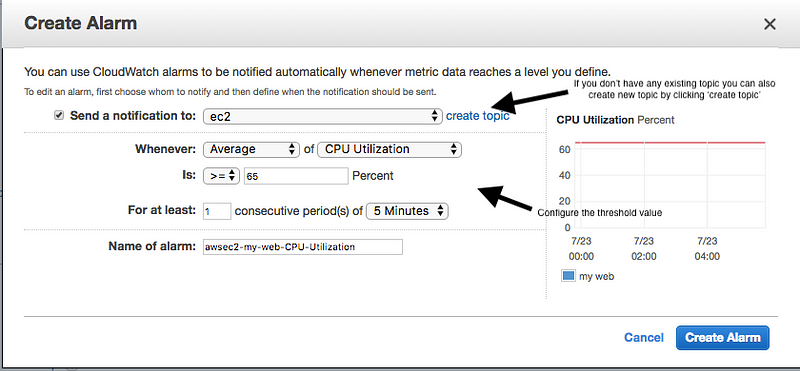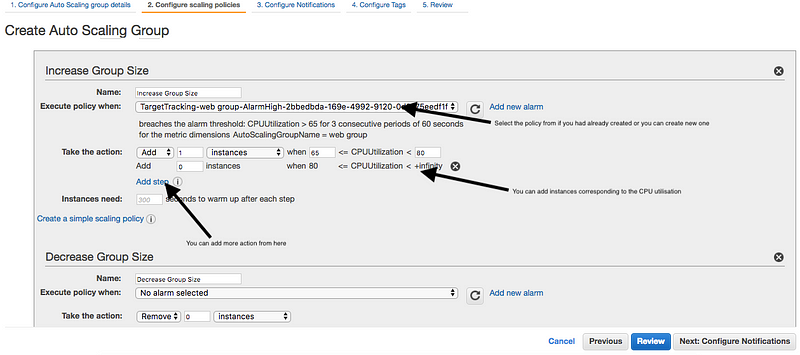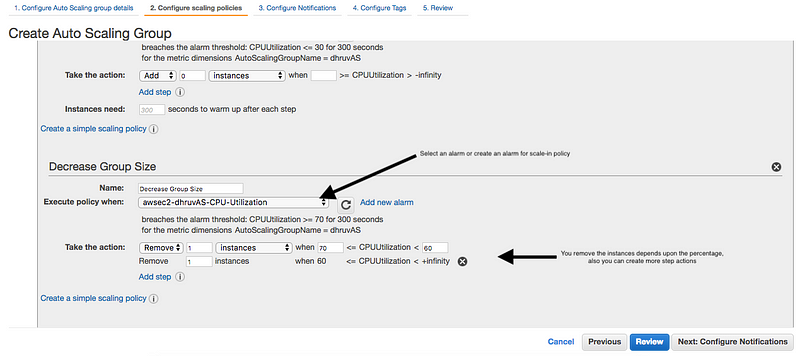EC2 Auto Scaling
EC2 Auto Scaling
In the traditional IT world, there's a restricted range of servers to handle the applying load. once the number of requests will increase the load on the servers additionally will increase, that causes latency and failures.Amazon internet service provides Amazon EC2 auto Scaling services to beat this failure. auto Scaling ensures that Amazon EC2 instances area unit ample to run your application. you'll be able to produce AN auto-scaling cluster that contains a set of EC2 instances. you'll be able to specify a minimum range of EC2 instance in this cluster and auto-scaling can maintain and make sure the minimum range of EC2 instances. you'll be able to additionally specify the most range of EC2 instances in every autoscaling cluster in order that auto-scaling can guarantee instances ne'er transcend that most limit.
You can additionally specify desired capability and auto-scaling policies for the Amazon EC2 auto-scaling. By victimization the scaling policy, auto-scaling will launch or terminate the EC2 instances looking on the demand.
Auto Scaling parts
Groups
Groups area unit the logical teams that contain the gathering of EC2 instances with similar characteristics for scaling and management purpose. victimization the auto scaling teams you'll be able to increase the number of instances to boost your application performance and additionally you'll be able to decrease the number of instances looking on the load to scale back your value. The auto-scaling cluster additionally maintains a fixed range of instances albeit an instance becomes unhealthy.
To meet the specified capability the autoscaling cluster launches enough range of EC2 instances, and additionally, car scaling cluster maintains these EC2 instances by performing arts a periodic medical exam on the instances within the cluster. If any instance becomes unhealthy, the auto-scaling cluster terminates the unhealthy instance and launches another instance to exchange it. victimization scaling policies you'll be able to increase or decrease the amount of running EC2 instances within the cluster mechanically to satisfy the dynamic conditions.
2. Launch Configuration
The launch configuration may be an example utilized by the car scaling cluster to launch EC2 instances. you'll be able to specify the Amazon Machine Image (AMI), instances kind, key pair, and security teams etc.. whereas making the launch configuration. you'll be able to additionally modify the launch configuration once creation. The launch configuration is used for multiple auto-scaling teams.
3. Scaling Plans
Scaling plans tells auto Scaling once and the way to scale. Amazon EC2 auto-scaling provides many ways in which for you to scale the autoscaling cluster.
Maintaining Current instance level in any respect time:- you'll put together and maintain a nominal range of running instances in any respect the time within the motorcar scaling cluster. to realize this Amazon EC2 motorcar-scaling performs a periodic medical examination on running EC2 instances inside an auto-scaling cluster. If any unhealthy instance happens, auto-scaling terminates that instance and launches new instances to exchange it.
Manual Scaling:- In Manual scaling, you specify solely the changes in most, minimum, or desired capability of your motorcar scaling teams. Auto-scaling maintains the instances with updated capability.
Scale supported Schedule:- In some cases, you recognize precisely once your application traffic becomes high. as an example on the time of restricted provide or some specific day in peak loads, in such cases, you'll scale your application supported regular scaling. you'll produce a regular action that tells Amazon EC2 auto-scaling to perform the scaling action supported the particular time.
Scale supported demand:- this is often the foremost advanced scaling model, resources scales by employing a scaling policy. supported specific parameters you'll scale in or scale out your resources. you'll produce a policy by the process the parameter like central processor utilization, Memory, Network In, and Out etc. as an example, you'll dynamically scale your EC2 instances that exceeds the central processor utilization on the far side seventieth. If central processor utilization crosses this threshold price, the motorcar scaling launches new instances mistreatment the launch configuration. you ought to specify 2 scaling policies, one for scaling In (terminating instances) and one for scaling out (launching instances).
Types of Scaling policies:-
Target tracking scaling:- supported the target price for a selected metric, Increase or decrease the present capability of the motorcar scaling group.
Step scaling:- supported a collection of scaling changes, increase or decrease the present capability of the group that varies supported the scale of the alarm breach.
Simple scaling:- Increase or decrease the present capability of the group supported one scaling adjustment.
Setup
As a pre-requisite, you would like to make Associate in Nursing AMI of your application that is running on your EC2 instance.
Go to EC2 console and click on Launch Configuration from auto Scaling
2. From select AMI, choose the Amazon Machine Image from My AMIs tab, that was wont to produce the image for your net application.

3. Then, choose the instance's sort that is appropriate for your net application and click on Next: piece details.

4. On piece details, name the launch configuration, you'll assign if any specific IAM role is appointed for your net application, and conjointly you'll change the elaborated observation.
5. After that, Add the storage and Security teams then opt for a review.
Note: Open the specified ports for your application to run.
6. Click on produce launch configuration and select the prevailing key pair or produce a replacement key pair
Setup: Auto Scaling Group:
From EC2 console click on motor vehicle Scaling cluster that is below the launch configuration. Then click on produce auto scaling group.
From motor vehicle scaling group page, you'll produce either victimization launch configuration or Launch example. Here I actually have created victimization Launch Configuration. you'll produce a replacement Launch Configuration from this page conjointly. Since you had already created the launch configuration, you'll opt for making auto scaling group by using “Use an existing launch configuration”.
3. when clicking on next step, you'll piece group name, group initial size, and VPC and subnets. Also, you'll piece load balance with the auto-scaling cluster by clicking Advanced Details.
After that click on next to piece scaling policies
4. On the scaling policy page, you'll specify the minimum and the most variety of instance during this group. Here you'll use target trailing policy to piece the scaling policies. In metric sort, you'll specify like central processor utilization and Network In or Out and conjointly you'll offer the target price further. looking at the target price the scaling policy can work. you'll conjointly disable scale-in from here.



It works supported alarm, so first, produce the alarm by clicking on ‘add new alarm’.

Here the alarm created relies on central processor utilization higher than sixty-fifth. If central processor utilization crosses sixty-fifth the motor vehicle scaling launches new instances supported the step action.

You can specify additional step actions supported your load, however, in easy policy, you can’t reason looking on the share of central processor utilization. Also, you would like to piece scale-in policies once the traffic becomes low, because it reduces the asking.

5. Next click on ‘Next: piece Notification’ to urge the notification supported launch, terminate, and fail etc. to your mail ID, and enter the tag and click on ‘Create auto scaling group’.
Note: you would like to make an Elastic Load balancer on prime of an auto scaling group.
Google+
Youtube
Altf9 Technology Solutions Pvt.Ltd
5/181, J4A Third Floor
Periyar Street, Medavakkam
Chennai, India
Pincode:600100.
INDIA: +91 8056005901
USA: +1 (845) 576-5295
Australia : +61291880753
info@altf9.in




Comments
Post a Comment